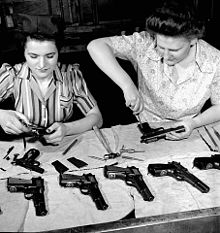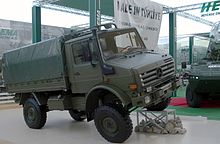Arms industry
Industrial sector which manufactures weapons and military technology and equipment / From Wikipedia, the free encyclopedia
Dear Wikiwand AI, let's keep it short by simply answering these key questions:
Can you list the top facts and stats about Arms industry?
Summarize this article for a 10 years old
The arms industry, also known as the defence industry, military industry, or the arms trade, is a global industry which manufactures and sells weapons and military technology. Public sector and private sector firms conduct research and development, engineering, production, and servicing of military material, equipment, and facilities. Customers are the armed forces of states, and civilians. An arsenal is a place where arms and ammunition – whether privately or publicly owned – are made, maintained and repaired, stored, or issued, in any combination. Products of the arms industry include weapons, munitions, weapons platforms, military communications and other electronics, and more. The arms industry also provides other logistical and operational support.

| Part of a series on |
| War |
|---|
|
The Stockholm International Peace Research Institute (SIPRI) estimated military expenditures as of 2018[update] at $1.822 trillion.[1] This represented a relative decline from 1990, when military expenditures made up 4% of world GDP. Part of the money goes to the procurement of military hardware and services from the military industry. The combined arms-sales of the top 100 largest arms-producing companies and military services companies (excluding China) totaled $420 billion in 2018, according to SIPRI.[2] This was 4.6 percent higher than sales in 2017 and marks the fourth consecutive year of growth in Top 100 arms sales. In 2004, over $30 billion were spent in the international arms trade (a figure that excludes domestic sales of arms).[3] According to the institute, the five largest exporters in 2014–18 were the United States, Russia, France, Germany and China whilst the five biggest importers were Saudi Arabia, India, Egypt, Australia and Algeria.[4]
Many industrialized countries have a domestic arms industry to supply their own military forces. Some countries also have a substantial legal or illegal domestic trade in weapons for use by their own citizens, primarily for self-defense, hunting or sporting purposes. Illegal trade in small arms occurs in many countries and regions affected by political instability. The Small Arms Survey estimates that 875 million small arms circulate worldwide, produced by more than 1,000 companies from nearly 100 countries.[5]
Governments award contracts to supply their country's military; such arms contracts can become of substantial political importance. The link between politics and the arms trade can result in the development of what U.S. President Dwight D. Eisenhower described in 1961 as a military–industrial complex, where the armed forces, commerce, and politics become closely linked, similarly to the European multilateral defense procurement. Various corporations, some publicly held, others private, bid for these contracts, which are often worth many billions of dollars. Sometimes, as with the contract for the international Joint Strike Fighter, a competitive tendering process takes place, with the decision made on the merits of the designs submitted by the companies involved. Other times, no bidding or competition takes place.
